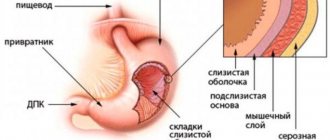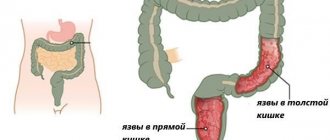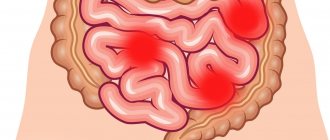According to the international classification of diseases ICD-10, the disease has code K25, which includes all types of stomach ulcers. It can be located in any of its sections - cardiac (initial), in the body area on the anterior and posterior walls, on the lesser and greater curvature, in the antrum - lower section and, finally, in the pylorus - pyloric section at the very exit from the stomach.
General information about stomach ulcers
Almost every person has experienced stomach pain due to irregular nutrition.
But with frequent painful sensations in the human stomach, patients are recommended to undergo examinations and tests, because such signals may be the first indicators of the development of a stomach ulcer. You should pay attention to the manifestations of signs of gastrointestinal diseases, because failure to consult a doctor in a timely manner can cause irreversible changes, which will require surgical intervention. If you suspect a stomach ulcer, it is recommended to immediately undergo diagnostics and examination by an experienced doctor, who will identify the causes and manifestations and prescribe appropriate effective treatment depending on the stage and specifics of the stomach ulcer.
In the first stages, the symptoms and manifestations are not too pronounced; it is for this reason that the transition of the disease to an acute advanced form can be missed. The danger of stomach ulcers lies in the fact that the mucous membrane, muscles, and the entire depth of the stomach wall are affected, which is why ulcers require timely detection and treatment. The signs become clear starting from the second stage of the disease.
Risk factors include neglecting hygiene rules before eating, eating from dirty dishes, and eating stale food. It is recommended to take full responsibility for the freshness of products and personal hygiene in order to avoid pathological processes in the gastrointestinal tract.
Symptoms of peptic ulcer
The main symptom is epigastric pain, which varies in intensity and radiates to the back, chest, and right hypochondrium. The pain is dependent on food intake; it can be at night, in the morning on an empty stomach, or “hungry” if food has not been taken for a long time during the day. As a rule, the pain subsides after eating.
Other symptoms are nausea, sour belching, vomiting, which often accompany pain, as well as heartburn, which is often accompanied by increased salivation.
Despite the fact that after eating there is relief from pain, another sign appears - a very unpleasant feeling of fullness and heaviness in the stomach. This is due to pyloric spasm and stagnation of food, especially if the volume is large. When the ulcer worsens, patients lose weight because they become afraid of eating.
Symptoms and causes of the disease
The main causes of the development of stomach ulcers can be:
- pathological inflammatory processes in the gastrointestinal tract;
- Among the common causes of the disease is an increased level of gastric acidity;
- the cause is constant alcoholism and drinking alcoholic beverages of different strengths;
- the reason may be chronic stress and depression;
- decreased immunity;
- Causes of ulcers can also occur under the influence of the pathogenic microorganism Helicobacter. Helicobacter multiplies in the acidic substance of the stomach, possessing some protective factors;
- Negative factors also include heredity, improper and irregular nutrition;
- the disease occurs as a result of consuming low-quality products, smoking, and taking certain medications with significant side effects for the gastrointestinal tract.
To establish the cause of stomach ulcers, it is also necessary to check the patient for concomitant diseases, such as diabetes, syphilis, pancreatitis, gastritis, tuberculosis, Crohn's disease, and cirrhosis of the liver.
Clinical manifestations of diseases of the stomach and duodenum are usually pronounced. The severity of symptoms is determined by the stage - remission or exacerbation. The symptoms manifest themselves most clearly during the period of exacerbation of ulcerative pathology, which is characterized by pronounced manifestations of signs of a stomach ulcer; they can be determined by a doctor during examination and during diagnosis using modern methods.
The main symptoms are:
- painful sensations in the epigastric zone of varying intensity - periodic or worsening. If you experience regular pain, you should check with a qualified doctor;
- a common symptom is hunger pain, which decreases after eating;
- The nature of the pain is different - from aching to sharp cutting. Depending on this symptom, drug treatment is prescribed to reduce pain and spasms;
- heartburn or rotten belching, which depends on the level of stomach acidity. Such symptoms are more often observed with increased acidity;
- Frequent symptoms include stool disorders - constipation with high acidity or diarrhea with low acidity;
- signs of an ulcer also include nausea, bloating;
- rumbling in the stomach, since the underlying parts of the gastrointestinal tract are susceptible to pathology.
Having noticed these signs in a timely manner, you must immediately consult a doctor at the hospital to make a diagnosis and prescribe an appropriate treatment regimen. If there is no response to the signs, the disease occurs with certain complications:
- perforation of the stomach, that is, the occurrence of a through defect connecting the lumen of the stomach with the peritoneal area;
- penetration or defect in the gastric mucosa, which is closed by a nearby organ (omentum or pancreas);
- bleeding in the gastrointestinal tract - special attention must be paid to this sign, it requires immediate hospitalization and, without taking action, leads to death;
- malignant oncological formation in the area of the ulcer.
Location and functions of the gatekeeper
The pylorus (in Latin - pylorus) is the shortest outlet section of the stomach, bordering the duodenal bulb. The name gatekeeper comes from the Old Slavic “at the gate,” that is, he himself opens and closes the exit from the organ.
This section is the shortest - only 1-2 cm long, with a narrow opening - the thickness of a finger; its wall contains quite powerful smooth muscles. The function of the department is to regulate the flow of food mass from the stomach into the intestines. When the smooth muscles of the stomach wall contract, a peristaltic wave occurs, and the pylorus relaxes, opening the outlet, then closes again.
A feature of the structure is the arrangement of the muscles and mucous membrane in the form of a fold-valve, which ensures one-way movement of food and prevents it from returning back to the stomach.
Diagnosis of ulcers: features and procedures
Diagnosis of the disease is carried out by an experienced gastroenterologist, who can determine an accurate diagnosis after examination, history taking and diagnostics using hardware methods.
The gastroenterologist analyzes the patient’s medical history and complaints, family history, and also carries out a number of diagnostic measures. An ulcer is diagnosed using a general blood and urine test, the acidity of gastric juice is examined, and diagnostics is carried out using esophagogastroduodenoscopy. If internal bleeding is suspected and for an accurate diagnosis, a stool test for occult blood is collected. The main goal of the doctor in diagnosis is to confirm the ulcerative defect in the stomach wall and the presence of Helicobacter in the patient. The disease is diagnosed in the following ways:
- X-ray method using barium suspension;
- fibrogastroduodenoscopy visualization of the gastric mucosa using a special magnifying device;
- urease method - based on the detection of urease in exhaled air, which occurs as a result of the proliferation of Helicobacter in the stomach;
- PCR diagnostics – determines the nucleic acid complexes that characterize Helicobacter;
- serological methods for diagnosing the disease, involving the determination of immunoglobulins to Helicobacter;
- specialized tests performed during fibrogastroduodenoscopy.
At the same time, examinations are performed to ensure the possibility of excluding the development of pathological complications. Ultrasound examinations of the peritoneal organs and X-ray contrast examination using barium are performed, which makes it possible to determine the size of the ulcer.
Pyloric ulcer
In diseases of the pylorus, the amount of acid changes up or down. As a result of this pathology, a sphincter ulcer develops. The functioning of the valve between the stomach and esophagus is impaired. Acid and other substances enter the esophagus, which contribute to the erosion of the intestines. Ulcers and burns form on its walls.
The pain becomes severe, often resembles spasms, and occurs at night. Patients begin to suffer from heartburn, belching rotten foods, and bloating. In rare cases, internal bleeding occurs in the stomach. During the progression of pyloric ulcers, patients are not helped by anti-heartburn medications and eating.
The pain begins to intensify. When the ulcer becomes complicated, the patient experiences vomiting with a sour taste. The patient is indicated for urgent surgical intervention. A pyloric ulcer develops as a result of an infectious lesion of the stomach or is acquired by inheritance.
The risk group includes patients who abuse alcoholic beverages, drink strong coffee, have an unbalanced diet, and often eat smoked, spicy foods and flour products. Regular stressful situations and lack of sleep lead to ulcerative lesions of the pylorus. If a patient is diagnosed with a gastric pyloric ulcer, treatment begins urgently.
Doctors treating the disease
A stomach ulcer requires a qualified, comprehensive approach, so treatment must be carried out in a specialized clinic, where, using modern equipment, research is carried out and a clear diagnosis is established.
For patients who are interested in the question of which doctor treats gastric dysfunction, the answer is clear - this is a gastroenterologist. A specialist conducts examinations and, based on them, prescribes effective treatment methods and surgical intervention for advanced stages of the ulcer. Patients who are disillusioned with general practitioners should contact a gastroenterologist with such a disease, who treats the immediate cause of the disease and helps to overcome the disease without serious consequences for the whole body. A qualified gastroenterologist, based on medical history, causes and symptoms, will determine the nature of the pathology and prescribe appropriate treatment.
Among the many clinics in Moscow where ulcers are diagnosed, one of the leaders is JSC Meditsina. To undergo examination, diagnosis and take appropriate tests, you need to register with a clinic, where you can choose an experienced doctor who will help you effectively and quickly cure the ulcer.
The clinic offers research using modern equipment that allows for color mapping, 3D modeling of tissues and blood vessels, which can be used to examine ulcers and changes in the stomach and gastrointestinal tract in detail, make an accurate diagnosis, and prescribe an effective treatment method. Thanks to high-precision color images, the doctor gets a clear picture of the ulcer.
Doctors at Dr. Roitberg's clinic with many years of experience help overcome the underlying causes, symptoms and manifestations of ulcers, and completely get rid of painful sensations, regardless of how painful the gastrointestinal tract organs are and how the disease progresses.
Prevention
Preventing a disease is always easier than treating it, so preventive measures must be followed. They consist of a healthy, proper diet, giving up bad habits, physical activity, and hardening the body. You should also not get carried away with certain medications – steroids, anti-inflammatory drugs – without your doctor’s knowledge.
For people with a labile nervous system who are unable to withstand psycho-emotional stress, it is useful to visit a psychologist, undergo psychocorrection, engage in meditation or auto-training, so that stress does not lead to the development of peptic ulcers and other diseases.
Treatment methods
Therapy for the disease should include comprehensive measures.
For the most effective treatment, after diagnosis, the doctor uses antibacterial medications, antispasmodics, prokinetics, medications to stabilize stomach acidity, and the patient is prescribed dietary nutrition if there are problems with the gastrointestinal tract. During the medical treatment of peptic ulcers, antibacterial drugs are used - Metronidazole, Furazolidone; medications that regulate acidity - Kvamatel, Omeprazole. In the absence of complications, treatment of ulcerative pathology is carried out conservatively. Surgical treatment methods and gastroscopy are indicated for certain complications, for example, perforation, bleeding in the gastrointestinal tract and other irreversible pathological or inflammatory processes. Also, medications and treatment methods are prescribed based on the stage of scarring of the walls.
Conservative therapy to combat ulcers takes a leading place and has two main goals:
- cause the death of Helicobacter;
- reduce the acidity of gastric juice to a stable level.
Three-component or four-component regimens can be used, depending on the severity of the inflammatory process.
In parallel, physiotherapy can be carried out (electrophoresis of drugs on the epigastric zone). Therapy mainly includes medication and proper nutrition. Surgery is indicated only for complications. Drug therapy for ulcers involves the prescription of antibacterial agents that help remove bacteria from the body. Treatment is carried out in stages:
- stage one - inhibitors or agents to normalize acidity and reduce the release of hydrochloric acid, are used together with antibacterial drugs based on clarithromycin, from the category of semi-synthetic penicillins. Taking medications lasts an average of a week. The dose and type of medications are prescribed by the doctor solely on the basis of an in-depth examination. If the patient is unresponsive to inhibitors, similar histamine H2 receptor blockers are prescribed. Already at this stage, 90% of patients experience complete elimination of bacteria;
- stage two is required if standard treatment does not bring results. Similar inhibitors are used with antibacterial agents from the group of nitroimidazoles and tetracyclines, and gastroprotectors are introduced. The drugs create a film on the walls of the stomach, which reduces pain, relieves inflammation, increases the resistance of the mucous membrane to negative influences, and restores the protection of the stomach. The duration of the treatment phase is a week or more.
During treatment, the doctor also prescribes concomitant medications aimed at alleviating symptoms: vitamins and medications that protect the mucous membrane from the effects of gastric juice, sedative medications (valerian), antispasmodics to reduce pain, probiotics that help stabilize the normal microflora of the gastrointestinal tract, since it suffers due to taking antibiotics.
An important element of the treatment regimen is the correct diet. You need to eat little and often, 5-6 times a day, without overeating. It is necessary that foods do not require prolonged chewing, since this activates the production of juice in the stomach. For stomach ulcers, it is better to eat purees, soufflés, omelettes, porridges and jelly, cutlets and meatballs, and casseroles.
Based on the stage and characteristics of the disease, the following diets are used:
- Table 1A – for exacerbations of pathology. The diet includes soups in the form of pureed cereals, steam soufflé, soft-boiled eggs, milk porridge, jelly, steamed fish;
- Table 1 – prescribed after exacerbations. Meals include white bread and crackers, vegetable and cereal puree soups, boiled lean meat, steamed fish, cottage cheese casseroles, ground porridge, omelettes, boiled vegetables, and lightly brewed tea. Prohibited are rye bread, meat with fat and streaks, rich broths, spicy and fried foods, marinades, fermented milk products, coffee;
- table 5 – used for remission. Allowed are milk, cottage cheese and low-fat sour cream, steamed cutlets, omelettes and soufflés, boiled and stewed fish, steamed cutlets, crackers and bran bread, and individual vegetables. You should not consume coffee and strong tea, sauces and spices, fatty and fried foods, sour fruits, fresh bread and confectionery, and smoked foods.
Diseases of the pylorus of the stomach
The pylorus refers to a muscle that is shaped like a hook. She takes part in the digestion of food. The sphincter is located in the lower part of the stomach and passes into the small intestine. This is the pyloric part of the digestive system. When hydrochloric acid is released, the pylorus closes inside the stomach.
In gastroenterology, the work of the pylorus is called the Serdyukov reflex. When it does not close and its contractility weakens, the muscle begins to deform. The sphincter does not close tightly, which is why various diseases of the digestive system occur. Decompensation of food into the duodenum occurs.
Pyloric pathologies:
- spasms;
- erosion and ulcers;
- pyloric stenosis;
- polyps;
- gatekeeper failure.
The functioning of the pylorus is closely related to the acid-base balance, the release of gastrin and other hormones. They are produced by the endocrine glands of the stomach.
Indications for stomach ulcers
Timely treatment ensures effective relief from the disease. Main indications for the treatment of ulcers:
- stop drinking alcohol, eat regularly and properly, exclude fried, fatty, spicy and salty foods;
- prevention of Helicobacter infection - for this it is recommended to follow standard recommendations;
- follow hygiene rules (wash hands before eating);
- wash food before eating;
- use fresh food and throw away spoiled food;
- Wash the dishes well, rinse off any remaining detergent.
Lifestyle in the presence of an ulcer is mainly determined by proper dietary nutrition, which is based on the following provisions:
- frequent and small meals (up to 5-6 times a day), while overeating must be avoided;
- eat enveloping foods, such as oatmeal;
- limit the use of extractive substances;
- give up animal fats;
- eat the portion of foods prescribed by your doctor or nutritionist that contain polyunsaturated fatty acids, which promote rapid healing of ulcers in the stomach and duodenum.
Types of pathologies and their clinic
Pathologies of the pylorus look like this:
- polyps;
- spasms;
- sphincter insufficiency;
- pyloric stenosis.
A pyloric polyp is a benign neoplasm that blocks the passage. This phenomenon interferes with the normal functioning and activity of the muscle. If you ignore the disease, there is a risk of the tumor transforming into a cancerous growth.
Sphincter spasms occur due to overstrain of muscle fibers. This causes difficulty in the passage of gastric juice into the small intestine, as the opening narrows. A similar problem can be caused by gastritis, gastric ulcers and congenital diseases of the digestive tract. Often in this state, the sphincter becomes large and begins to stretch, which helps to relieve its functions. In this condition, the patient may experience the following symptoms:
- pain after eating;
- slight weight loss;
- bad breath;
- nausea;
- vomit;
- frequent urge to urinate;
- colorless urine.
Pyloric insufficiency is a disorder of motor activity in which the muscle does not close completely, which leads to accelerated emptying or release of duodenal contents. Characteristic symptoms for this pathology are:
- yellowish coating on the tongue;
- stomach ache;
- bitter taste;
- belching;
- vomiting with bile;
- discomfort inside the peritoneum.
Gastric pyloric stenosis is a serious disease that occurs due to chronic ulcers. Scarring of the healing tissue at the site of ulcerative lesions, which occurs over a long period of time, leads to gastric obstruction. This negatively affects digestion, causing some symptoms:
- burping;
- vomiting of undigested food particles;
- feeling of heaviness under the ribs;
- rumbling in the abdominal cavity;
- painful attacks.
When the pylorus of the stomach is diseased, symptoms of general malaise and dizziness are also observed. Taken together, such manifestations bring the patient a lot of unpleasant sensations.
Cost of initial appointment, research, treatment
Prices for medical treatment are shown on the website for patients’ information.
To clarify the current cost of treatment, you need to make an initial consultation with a gastroenterologist, at which the doctor will conduct diagnostic measures and examination, identify the features of the pathology, and prescribe treatment with modern techniques and medications. The price of treatment directly depends on diagnostic measures and therapy, but in each specific case of gastric ulcer the most effective drugs are prescribed depending on the symptoms and stage of the disease. In advanced stages, it is necessary to treat the ulcer with the help of surgical interventions, followed by a hospital stay in the clinic to resolve the worsened manifestations and complications. The clinic offers innovative technologies, detailed analysis and comfortable living conditions.
Advantages of treatment at the clinic of JSC "Medicine"
JSC "Medicine" (clinic of academician Roitberg) is a multidisciplinary medical center that provides a range of services, including surgery and hospital stays.
Treatment at the clinic of JSC "Medicine" has the following advantages:
- license to carry out medical activities, receive patients, perform operations;
- each doctor has appropriate qualifications and significant experience in domestic and foreign clinics, and their achievements are posted on the medical center’s website;
- high-tech innovative equipment for conducting tests and examinations to establish the true causes of pathological conditions of the gastrointestinal tract;
- cooperation with insurance companies, profitable loyalty programs for corporate clients.
Doctors conduct a thorough and in-depth analysis of the patient’s health status, identify the underlying causes that led to the occurrence of stomach ulcers, and prescribe effective therapy on an outpatient or inpatient basis.











